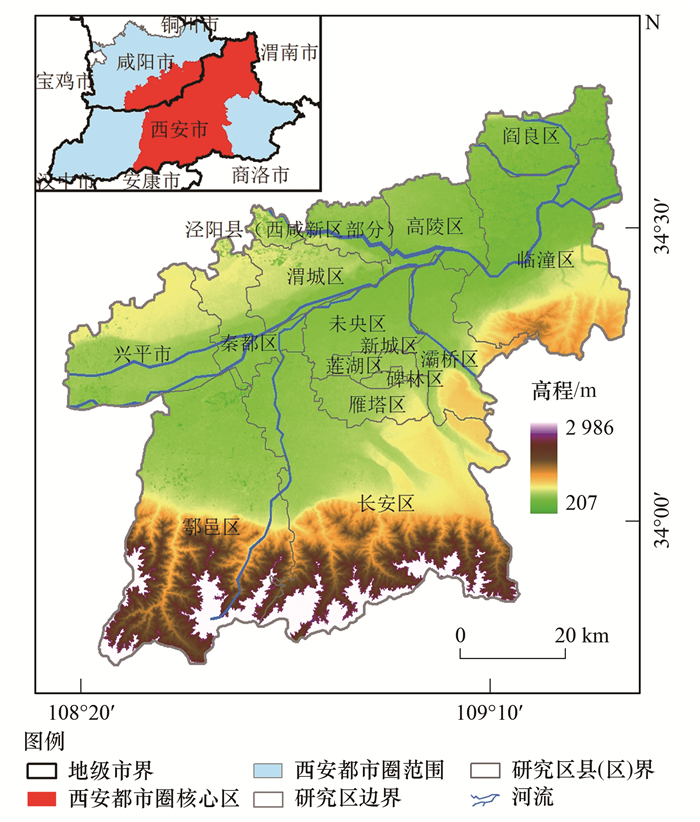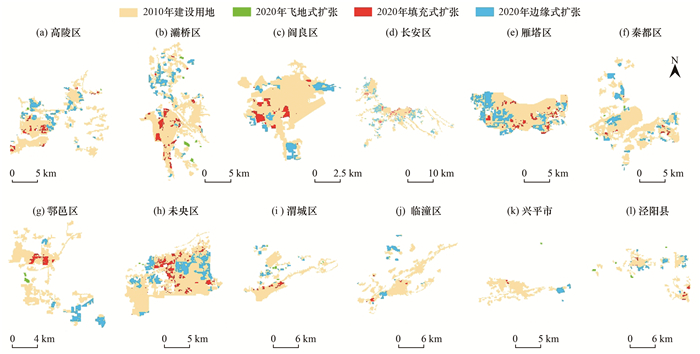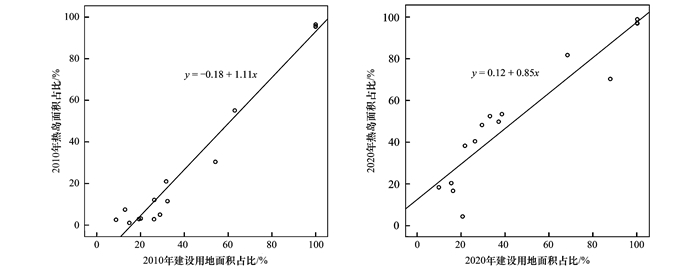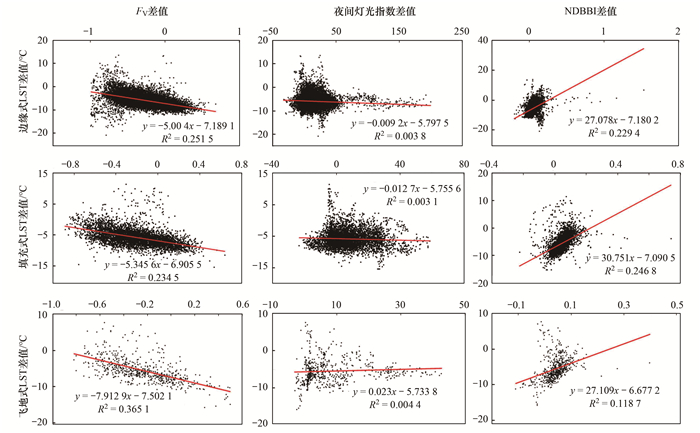2. 兰州大学资源环境学院, 兰州 730000
2. College of Earth and Environmental Sciences, Lanzhou University, Lanzhou 730000, China
联合国2018年《世界城镇化展望报告》指出, 世界城市化率在2050年将达到68%, 中国作为主要新兴经济体之一, 城镇化率在2010~2020年间增长14.21%, 城市化导致建设用地扩张进而使城市热环境恶化[1~3].热环境问题加剧不仅使城市人居环境质量变差, 还给城市能源和生态环境造成较大压力[4~6].研究城市扩张进程中城市热环境的演变和响应对打造生态和宜居城市具有重要意义.因此, 目前城市热环境成为城市气候和环境研究热点之一[7, 8].
当前已有大量基于星载遥感和统计数据的城市扩张与热环境关系研究, 结果表明城市扩张的表现为城市建设用地增多, 建筑物密度和高度增加, 城市人口和产业增多, 生态用地面积减少[9~11].上述情况导致不透水面和人为热排放增多, 城市表面粗糙度增加, 降温区域面积减少, 从而提高了地表温度(land surface temperature, LST)[12~14], 进而造成城市热环境恶化.综合目前研究来看, 城市形态、社会经济活动对城市热环境的影响强烈[15~17].但星载遥感和统计数据目前无法精确对社会经济和城市三维形态等因素进行空间化表征[18~22].近年来, 部分学者尝试利用网络大数据解决这一问题, 证明网络大数据在社会经济和城市三维形态因素表征方面具有可空间化、精细化和实时性强的优势[23~25].但目前研究对于网络大数据应用多局限于兴趣点(points of interest, POI)与星载遥感数据[26~28], 还可继续综合其他数据源进行多因素综合研究.因此, 本文在前人研究的基础上, 利用百度热力指数、POI数据表征社会经济因素, 网络地图建筑轮廓数据表征城市三维形态, 构建一个由城市自然状况、城市空间规模和社会经济这3个方面综合的城市扩张表现体系, 研究城市热环境对城市扩张的响应.
另外, 西安作为西北地区唯一的国家中心城市, 经济发展程度较高, 热环境问题突出.当前研究多以西安市域或建成区为研究对象[29~32], 对西安都市圈核心区研究较少.随着西咸接合片区成为11个国家城乡融合发展实验区之一, 西安都市圈核心区城市化水平不断提升, 热环境迎来严峻挑战.在此背景下, 平衡好都市圈发展与热环境效应之间的关系, 是西安都市圈核心区生态文明建设的重要组成部分.
本文以西安都市圈核心区为研究对象, 识别2010~2020年城市扩张及热环境时空演变状况, 利用百度热力指数、建筑轮廓数据、遥感数据和POI数据等多源数据, 在社会经济活动精确表征, 城市三维形态与其他因素综合研究两方面进行创新, 对城市热环境与城市扩张的关系进行研究, 通过科学全面地揭示研究区城市扩张中热环境演变规律, 以期为改善城市热环境提供理论参考.
1 材料与方法 1.1 研究区域西安都市圈核心区位于关中平原中部和泾渭两河交汇处[33, 34], 包括西安市、咸阳市城区、西咸新区和兴平市(图 1), 总面积约6 453 km2, 占陕西省总面积的3.1%. 2010~2020年常住人口增加392.89万人, 2020年总人口已突破1 000万人, GDP增长4 714.48亿元, 占陕西省GDP增长的18%, 近年来城市建设用地扩张迅速, 城市热环境逐渐恶化.

|
图 1 研究区域示意 Fig. 1 Study area schematic |
本文选取Landsat数据, 利用ENVI 5.3软件中Radiometric Calibration和FLAASH Atmospheric Correction工具对其进行辐射定标和大气校正, 基于多尺度分割的多影像局部填充模型[35]以2019年8月29日影像为填充影像(两日平均气温相差1.5℃), 进行去云处理.使用最大似然监督分类方法解译土地利用类型, 根据各地类占比通过Google Earth高分辨率影像目视解译和部分区域现场调查随机选取各地类共164个验证样区对遥感解译准确度进行评估, 结果整体准确度为90.12%, Kappa系数0.85, 结果符合研究需求.
2020年研究区网络大数据包括: POI、百度热力指数和建筑轮廓数据.其中POI数据剔除重复、无效、公园绿地和风景名胜点共8 698个点后, 剩余824 333个; 建筑轮廓数据共133 723个建筑面.其他数据还包括夜间灯光和DEM数据.为便于计算, 将数据空间分辨率统一至30 m×30 m, 并统一空间参考(表 1).
|
|
表 1 数据类型及获取途径 Table 1 Data type and access method |
1.3 研究方法 1.3.1 城市扩张指数计算
选取城市扩张强度和景观扩张指数表征城市扩张状况.城市扩张强度指数用以表达单位时间内城市扩张强弱:

|
(1) |
式中, UEI为城镇建设用地扩张强度指数; At1和At2分别为t1和t2时间段研究区城镇建设用地面积; Δt为t1~t2的间隔年份.
景观扩张指数[36]用以识别城市扩张模式, 包括飞地式、填充式和边缘式.其中, 填充式指在建成区内部扩张的模式; 边缘式指沿已有建设用地边缘向外扩张的模式; 飞地式指新扩张用地空间上不与既有用地接触的扩张模式:

|
(2) |
式中, LEI为景观扩张指数, Lcom为新增城市用地与现有城市用地的共同边界长度; Pnew为新增城市用地的周长; 飞地式LEI=0, 边缘式0<LEI≤0.5, 填充式0.5<LEI≤1.
1.3.2 LST反演参照文献[37], 利用辐射传输方程法通过Landsat数据进行LST反演.从NASA官网(http://atmcorr.gsfc.nasa.gov/)获取透过率和大气上辐射亮度.地表比辐射率计算采用混合像元分解法将遥感影像分为水体、城镇和自然表面这3种类型.

|
(3) |

|
(4) |
式中, εsurface和εbuilding为自然表面和城镇的比辐射率; FV为植被覆盖度, 依据归一化植被指数值(NDVI)确定.

|
(5) |

|
(6) |
式中, NDVIV=0.70, NDVIS=0.当某个像元NDVI>0.70时, FV取值为1; NDVI<0时, FV取值为0.
热红外辐射亮度值为:

|
(7) |

|
(8) |
式中, Lλ为地表辐射率, TS为地表真实温度, B(TS)为通过普朗克定律推出的黑体热辐射亮度, τ为大气在热红外波段的透过率, L↑为大气上辐射亮度, L↓为地面真实辐射亮度经过大气层后传达到卫星传感器的能量.参照普朗克公式的反函数, 得出地表真实温度TS, 单位为℃.

|
(9) |
式中, K1和K2为Landsat5 TM参数时, 分别为666.09 W·(m2·sr·μm)-1和1282.7 K; 为Landsat8 OLI参数时, 为774.885 3 W·(m2·sr·μm)-1和K2=1 321.078 9 K.
通过标准差法将LST分为极低温区、低温区、较低温区、中温区、较高温区、高温区和极高温区这7个等级.根据2020年统计反演结果得LST主要分布在32~40℃之间.由于较高温区、高温区和极高温区LST值高于平均值, 因此本文将这些区域视为城市热岛区.
1.3.3 因子计算和统计分析方法本研究根据以往研究并结合研究区区位特征选取11个因素分析响应机制(表 2), 部分指数计算方法如下.
|
|
表 2 城市热环境影响因素 Table 2 Influencing factors of urban thermal environment |
改进的归一化差值水体指数(MNDWI)用来表征水体信息[38].

|
(10) |
归一化差值不透水面指数(NDISI)为城市下垫面主要组成部分[39].

|
(11) |
归一化差值裸地与建筑指数(NDBBI)反映裸地和建筑用地信息.

|
(12) |
式中, Green、SWIR1、TIRS1、NIR和SWIR2分别对应Landsat5 TM第2、5、6、4和7波段, Landasat8 OLI第3、6、10、5和7波段.
地表反照率(Albedo)为决定地表吸收太阳辐射和地表能量收支的重要参数.

|
(13) |
式中, ai为Landasat8 OLI第i波段灰度值.
其他因子还包括: DEM和坡度指数反映地形; 通过ArcGIS 10.7平台将网络建筑轮廓数据栅格化, 形成建筑高度数据, 反映城市三维形态; 利用经过矫正处理的2010年和2020年夜间灯光数据表现人为活动强度; 利用重采样的百度热力数据反映人口分布; POI数据核密度分析结果表征产业集聚情况.
本文利用空间主成分分析方法[40]来去除冗余信息, 克服多因子共线性问题, 方便进行城市热环境响应分析.空间主成分分析方法中一般将特征值大于1, 累计方差贡献率超过80%作为因子选取标准.
本文还利用Pearson相关性分析检验城市扩张各因子与LST之间相关性大小; 通过标准差线性回归模型探究LST对各城市扩张因子响应.
2 结果与分析 2.1 城市扩张时空演变特征2010~2020年研究区城镇建设用地共扩张200.84 km2, 扩张面积及强度呈现“中心和外围较弱, 两者之间较强”特征, 不同区县表现出较大差异(表 3).其中, 长安区、雁塔区、未央区和灞桥区建设用地扩张面积分别为50.55、37.62、36.96和21.60 km2, 共占总体扩张面积的73.06%, 扩张强度分别为0.024 5、0.039 2、0.025 9和0.020 9.阎良区、新城区、碑林区和莲湖区建设用地面积变化不明显, 扩张强度均在0.001以下, 其中阎良区和新城区建设用地面积出现下降趋势.究其原因, 新城区土地利用率高, 已经步入城市更新阶段; 而阎良主城区外围部分乡镇建设用地恢复为耕地, 导致总量建设用地减少, 但阎良主城区呈扩张趋势.
|
|
表 3 2010~2020年研究区城市扩张数量特征 Table 3 Quantitative characteristics of urban expansion in the study area from 2010 to 2020 |
为排除其他建设用地干扰, 本文根据各区县城乡总体规划提取城市建设用地范围并进行景观扩张模式识别, 各区县扩张模式以边缘式和填充式为主, 飞地式扩张较少, 3种扩张模式面积分别为169.28、49.64和6.09 km2, 扩张斑块数量分别为386、640和37个.边缘式扩张面积占比较大, 各区县边缘式扩张面积占比均高于50%, 其中兴平市[图 2(k)]和秦都区[图 2(f)]边缘式扩张面积占比均超过85%; 填充式扩张面积占比均较小, 但扩张斑块数量占比较大, 大部分区县呈与边缘式扩张斑块数量占比相近的情况, 均为40%左右, 但雁塔区、灞桥区、阎良区和未央区填充式斑块数量占比超过60%; 飞地式扩张斑块面积及数量占比均较小, 大部分区县占比均在5%左右, 其中渭城区[图 2(i)]和泾阳县(西咸新区部分)[图 2(l)]斑块数量及面积占比在10%左右.

|
由于莲湖区、碑林区和新城区城市空间扩张特征不明显, 不予表现 图 2 2010~2020年城镇建设用地扩张类型空间分布 Fig. 2 Spatial distribution of expansion types of urban construction land from 2010 to 2020 |
由表 4可知, 2010~2020年研究区热岛面积共增加282.65 km2, 增长16.28%, 最高温差为1.35℃.从温度分区来看, 2010~2020年中温区面积下降516.21 km2, 占比分别为53.88%和45.86%, 降幅接近8%, 并有向较高温区转变的态势; 较高温区面积增加407.86 km2, 占比分别为22.08%和28.38%, 增幅为6.3%; 高温区和极高温区面积分别减少81.76和43.45 km2, 降幅分别为1.27%和0.68%.
|
|
表 4 2010年和2020年地表温度面积及占比 Table 4 Surface temperature area and proportion in 2010 and 2020 |
2010年和2020年各区县热环境变化存在较大差异(表 5).其中, 碑林区、莲湖区和新城区热岛面积变化较小, 研究期内均被热岛区覆盖, 占比下降2%左右, 最高温度分别下降1.04、1.89和1.74℃, 表明三区热岛效应减弱, 热环境改善明显.但其余区县热岛面积均呈上升趋势, 城市热环境趋于恶化, 未央区、阎良区和高陵区最为明显, 面积增长分别为77.7、78.19和74.22 km2, 分别增加30%、32%和26%, 三区最高温度分别上升1.02、0.03和0.9℃, 西安经济技术开发区和沣东新城为明显高温集聚区, LST最高值达到52.62℃.其余区县热岛均呈现以建成区为中心的不规则环状扩展, 表明城市扩张与热环境恶化存在一定相关性.
|
|
表 5 2010年和2020年各区县地表温度等级面积/km2 Table 5 Surface temperature grade area of each district and county in 2010 and 2020/km2 |
2010年和2020年研究区热岛空间分布特征相似(图 3): 热岛集中分布于建筑、人口集聚的城市建成区和城市交通道路沿线; 中温区则主要分布在江河、公园绿地、内湖和未建设用地等区域; 而较低温区、低温区、极低温区分布于南部山地, 表现出明显的冷岛效应.两期时序图对比发现, 热岛区域沿着城市建成区不断扩展, 研究区北部及西部热岛扩张明显, 热岛分布格局由“东南-西北”向“东北-西南”转变.

|
图 3 2010年和2020年研究区热环境空间格局 Fig. 3 Spatial pattern of thermal environment in the study area in 2010 and 2020 |
本文以2010年和2020年各区县城市建设用地占比为自变量, 城市主要热岛面积占比为因变量, 建立城市建设用地扩张与热岛变化的回归模型(图 4), 探究城市扩张与LST的相关性.回归结果R2分别为0.937和0.984, 显著性水平P<0.01, 呈现明显的线性正相关.且2010~2020年间, 散点图中各点呈现向右上方移动的现象, 表明建设用地扩张将会导致热岛面积增加.

|
图 4 各区(县)建设用地面积和热岛面积占比相关性 Fig. 4 Correlation of the area of construction land and the proportion of heat island area in each district and county |
综上, 城市建设用地扩张与热环境演变存在相关性.由于2020年热岛效应相较2010年明显, 同时考虑研究时效性问题, 本文以2020年为基础进行相关性分析及后续响应分析.随机选取500个样本点, 经多次尝试后, 建立500 m半径缓冲区形成样区, 并获取各个样区位置处指数平均值和LST平均值, 最终通过Pearson分析识别各因素与城市热环境效应的相关性大小(表 6).自然因素中FV和MNDWI等与LST之间呈显著负相关性, 表明植被、水体具有缓解城市热岛效应的作用.NDISI、POI密度指数和热力指数与LST之间呈显著正相关性, 表明建成区人类活动所产生的热量, 难以较快散热, 易引起城市热环境恶化.
|
|
表 6 影响因子与地表温度Pearson分析1) Table 6 Pearson analysis of impact factors and surface temperature |
2.3.2 城市热环境响应分析
为研究热环境响应差异, 对各因子归一化处理后进行空间主成分分析, 得出前2个主成分特征值大于1, 因子贡献率超过85%.第1主成分主要包括NDBBI和FV等, 可以概括为城市空间规模和自然因素影响; 第2主成分主要为POI密度指数和热力指数, 可以概括为社会经济活动影响(表 7).
|
|
表 7 主成分得分载荷矩阵 Table 7 Principal component score loading matrix |
为继续分析主成分因子对城市热环境的影响程度, 对随机选取的500个样区进行数值提取, 将各主成分模拟指数样区平均值与归一化LST平均值在SPSS 21.0软件中进行线性回归分析.结果显著性系数均小于1%, 且方差膨胀因子小于10.采用标准化回归模型比较各主成分不同量纲指标间的作用程度.结果表明11个影响因子(表 7)每变化1个单位, 研究区LST将分别变化0.475、-0.822、0.793、0.678、0.277、0.318、-0.733、-0.804、0.337、-0.631和0.353个单位, 人文活动作用较自然因素强, 共同作用下地表共升温0.241个单位.
自然因素中, FV对热环境改善有较大作用, 贡献率为24.52%, 表明植被对于城市热岛降温作用较强; 水体降温作用较小, 贡献率为21.10%, 研究区内河流宽度和人工湿地面积较小, 其冷岛辐射较弱, 故降温作用较差.城市空间规模因素中NDBBI和NDISI正向影响较为突出, 贡献率分别为45%和39%.表明随着城市建设, 裸地及建设用地面积增多, LST升高明显.建筑高度增温效果相对其他因素较低, 贡献率为16%.社会经济增加方面POI密度指数、热力指数和夜间灯光指数这3个指标贡献率分别为28%、31%和41%.
3 讨论 3.1 城市扩张模式与LST的动态关系本文发现LST对各城市扩张模式响应不同, 而已有研究鲜见对这一方面的探讨, 有必要对其进行研究.经统计, 边缘式、飞地式和填充式分别增温3.10、1.10和1.98℃, 增温后LST最高值排序为: 填充式>边缘式>飞地式.为探究造成这种差异的原因, 经过反复实验, 选定100 m格网, 取各格网内部LST和3方面贡献率最大因子两年差值的平均值进行回归分析, 结果显示FV和NDBBI通过1%显著性检验, 夜间灯光指数通过5%显著性检验(图 5).

|
图 5 LST对各不同模式城市扩张主要因素的响应结果 Fig. 5 Response of LST to the main factors of urban expansion in different modes |
填充式扩张NDBBI增长系数最强, 标准化系数为0.497, 其次是边缘式(0.479), 最后是飞地式(0.345); FV下降系数排序依次为飞地式(-0.604)、边缘式(-0.502)和填充式(-0.484).表明NDBBI的上升是填充式和边缘式扩张中的主要升温因素, 可解释25%和23%的增温, 而FV降温作用较弱, 飞地式扩张LST对FV响应速度最快, 可解释其37%的增温, NDBBI虽起到较大作用, 但响应较小.3种扩张模式中夜间灯光指数相关性不明显, 但仍存在差异, 响应程度依次为: 飞地式>边缘式>填充式.3种模式对夜间灯光响应差异表明, 飞地式LST对人为热排放最敏感, 也表现出LST对人为热排放响应大小随着与城市建成区距离增加出现增强趋势.计算3项指标总体增温效果后, 飞地式扩张城市LST增温最低, 填充式和边缘式扩张相似, 这与之前统计结果相互印证.LST对飞地式扩张的FV响应在各模式和因素中最强, 反映其增温效率最高, 而填充式在增温效率方面比边缘式扩张稍小.
3.2 热环境变化机制探讨城市扩张包含城市空间规模扩大和社会经济活动增强两个主要方面.一方面, 城市空间规模扩大破坏地表植被, 导致蒸散发作用减弱, 不透水面面积和地块平均高度增加, 改变下垫面属性和地表粗糙度, 同时伴随地表反射率变化, 导致地表比热、地表能量收支和近地面风环境发生变化, LST升高.相关研究发现植被和水体减少[41, 42], 不透水面面积增多[43, 44], 建筑高度增加[45]与LST上升表现出较强正相关性, 与本研究结果一致.此外, 本研究发现LST对城市二维扩张响应更为强烈, 对三维扩张响应则较小.这可能由于城市三维扩张主要通过影响城市风环境阻碍城市与周边低温地区空气对流使高温难以扩散, 但大气运动具有不稳定性, 且随着建筑高度增加, 阴影面积也随之增大, LST可能出现部分地区降低的现象, 这与Sun等[46]的研究结果相似.另一方面, 随着城市空间规模扩大, 社会经济活动增加导致人为活动强度增加和人口、产业增多与集聚, 城市的能源需求、交通需求[47]和因集聚产生的热量逐渐增加, 导致LST上升.但不同于单方面研究人为热排放与LST关系的文章[48~50], 本研究发现社会经济活动增温作用明显弱于城市空间规模, 这与Singh等[51]的研究结果相似.表明进行城市扩张与热环境关系研究时需要利用多源数据对多方面因素进行考虑.
在综合考虑LST响应程度后, 为减缓城市热环境恶化, 城市空间规模扩大过程中应注意提高三维扩张强度, 摒弃“摊大饼”模式, 扩张模式要以边缘式扩张为主.同时, 城市社会经济活动增加要注重分散人口, 完善功能区布局, 工业区多以边缘式或距离城区较近的飞地式布局.针对植被降温规划, 应主要对城市现有主要廊道进行绿化, 减少在城市中进行填充式公园绿地修建.依据不同因素与LST的关系, 进行城市有序扩张是改善城市热环境的重要举措.
本研究对于指导西安都市圈核心区城市层面国土空间规划以及考虑热岛缓解的规划方案制定具有理论和现实意义.但研究受制于Landsat数据的时间分辨率, 尚未对夜晚热环境进行研究, 缺乏各因素对夜间热环境的影响认识, 后续研究需加强Landsat遥感影像与MODIS影像的融合, 产出高空间高时相分辨率热红外影像, 配合现有大数据进行多时相的城市热环境研究.
4 结论(1) 2010~2020年研究区城市扩张迅速, 城市扩张强度大, 呈现“中心和外围较弱, 两者之间较强”的特征.城市扩张形式以边缘和填充式为主, 且更倾向于以原有建设用地为基础扩张.
(2) 研究区整体热环境趋于恶化, 但中心区热环境改善明显, 分布格局由“东南-西北”向“东北-西南”演变.
(3) 城市热岛主要集中在工商业和人口密集区域, 冷岛则分布于非建设用地、水体和山体等地区; 热岛蔓延与城市扩张方向一致, 建设用地与热岛面积呈强正相关关系.
(4) 响应分析结果显示, 城市地表参数和二维形态变化依然是热环境变化的主要因素, 三维形态和社会经济活动升温作用相比较小, 各因素综合将会导致地面升温0.241个单位.
| [1] |
刘勇洪, 徐永明, 张方敏, 等. 北京城市空间形态对热岛分布影响研究[J]. 地理学报, 2021, 76(7): 1662-1679. Liu Y H, Xu Y M, Zhang F M, et al. Influence of Beijing spatial morphology on the distribution of urban heat island[J]. Acta Geographica Sinica, 2021, 76(7): 1662-1679. |
| [2] |
李宇, 周德成, 闫章美. 中国84个主要城市大气热岛效应的时空变化特征及影响因子[J]. 环境科学, 2021, 42(10): 5037-5045. Li Y, Zhou D C, Yan Z M. Spatiotemporal variations in atmospheric urban heat island effects and their driving factors in 84 major Chinese cities[J]. Environmental Science, 2021, 42(10): 5037-5045. |
| [3] | Halder B, Bandyopadhyay J, Banik P. Monitoring the effect of urban development on urban heat island based on remote sensing and geo-spatial approach in Kolkata and adjacent areas, India[J]. Sustainable Cities and Society, 2021, 74. DOI:10.1016/j.scs.2021.103186 |
| [4] | Ma W J, Zeng W L, Zhou M G, et al. The short-term effect of heat waves on mortality and its modifiers in China: an analysis from 66 communities[J]. Environment International, 2015, 75: 103-109. DOI:10.1016/j.envint.2014.11.004 |
| [5] | Song J, Pan R B, Yi W Z, et al. Ambient high temperature exposure and global disease burden during 1990-2019: an analysis of the global burden of disease study 2019[J]. Science of the Total Environment, 2021, 787. DOI:10.1016/j.scitotenv.2021.147540 |
| [6] | Sedaghat A, Sharif M. Mitigation of the impacts of heat islands on energy consumption in buildings: a case study of the city of Tehran, Iran[J]. Sustainable Cities and Society, 2021, 76. DOI:10.1016/j.scs.2021.103435 |
| [7] | Zhou D C, Xiao J F, Bonafoni S, et al. Satellite remote sensing of surface urban heat islands: progress, challenges, and perspectives[J]. Remote Sensing, 2019, 11(1). DOI:10.3390/rs11010048 |
| [8] |
姚远, 陈曦, 钱静. 城市地表热环境研究进展[J]. 生态学报, 2018, 38(3): 1134-1147. Yao Y, Chen X, Qian J. Research progress on the thermal environment of the urban surfaces[J]. Acta Ecologica Sinica, 2018, 38(3): 1134-1147. |
| [9] | Wang J T, Qu S Y, Peng K, et al. Quantifying urban sprawl and its driving forces in China[J]. Discrete Dynamics in Nature and Society, 2019, 2019. DOI:10.1155/2019/2606950 |
| [10] | Zhang C, Miao C H, Zhang W Z, et al. Spatiotemporal patterns of urban sprawl and its relationship with economic development in China during 1990-2010[J]. Habitat International, 2018, 79: 51-60. DOI:10.1016/j.habitatint.2018.07.003 |
| [11] |
黄木易, 岳文泽, 何翔. 长江经济带城市扩张与经济增长脱钩关系及其空间异质性[J]. 自然资源学报, 2018, 33(2): 219-232. Huang M Y, Yue W Z, He X. Decoupling relationship between urban expansion and economic growth and its spatial heterogeneity in the Yangtze economic belt[J]. Journal of Natural Resources, 2018, 33(2): 219-232. |
| [12] |
周玄德, 郭华东, 孜比布拉·司马义. 城市扩张过程中不透水面空间格局演变及其对地表温度的影响——以乌鲁木齐市为例[J]. 生态学报, 2018, 38(20): 7336-7347. Zhou X D, Guo H D, Zibibula·Simayi. Spatial pattern evolution of impervious surfaces and its influence on surface temperature in the process of urban expansion: a case study of Urumqi[J]. Acta Ecologica Sinica, 2018, 38(20): 7336-7347. |
| [13] |
孙然好, 王业宁, 陈婷婷. 人为热排放对城市热环境的影响研究展望[J]. 生态学报, 2017, 37(12): 3991-3997. Sun R H, Wang Y N, Chen T T. Impacts of anthropogenic heat emissions on urban thermal environment: a review[J]. Acta Ecologica Sinica, 2017, 37(12): 3991-3997. |
| [14] | Tian P, Li J L, Cao L D, et al. Assessing spatiotemporal characteristics of urban heat islands from the perspective of an urban expansion and green infrastructure[J]. Sustainable Cities and Society, 2021, 74. DOI:10.1016/j.scs.2021.103208 |
| [15] | Liu Y, Li Q, Yang L, et al. Urban heat island effects of various urban morphologies under regional climate conditions[J]. Science of the Total Environment, 2020, 743. DOI:10.1016/j.scitotenv.2020.140589 |
| [16] | Guo A D, Yang J, Xiao X M, et al. Influences of urban spatial form on urban heat island effects at the community level in China[J]. Sustainable Cities and Society, 2020, 53. DOI:10.1016/j.scs.2019.101972 |
| [17] |
陈一溥, 郑伯红. 长株潭城市群人为热排放对城市热环境影响研究[J]. 长江流域资源与环境, 2021, 30(7): 1625-1637. Chen Y P, Zheng B H. Study on the impact of human heat emission on the urban thermal environment of Changsha Zhuzhou Xiangtan urban agglomeration[J]. Resources and Environment in the Yangtze Basin, 2021, 30(7): 1625-1637. |
| [18] | Li X M, Zhou Y Y, Asrar G R, et al. The surface urban heat island response to urban expansion: a panel analysis for the conterminous United States[J]. Science of the Total Environment, 2017, 605-606: 426-435. DOI:10.1016/j.scitotenv.2017.06.229 |
| [19] | Yao R, Wang L C, Huang X, et al. Interannual variations in surface urban heat island intensity and associated drivers in China[J]. Journal of Environmental Management, 2018, 222: 86-94. |
| [20] |
杨智威, 陈颖彪, 吴志峰, 等. 粤港澳大湾区城市热岛空间格局及影响因子多元建模[J]. 资源科学, 2019, 41(6): 1154-1166. Yang Z W, Chen Y B, Wu Z F, et al. Spatial pattern of urban heat island and multivariate modeling of impact factors in the Guangdong-Hong Kong-Macao Greater Bay area[J]. Resources Science, 2019, 41(6): 1154-1166. |
| [21] |
曹畅, 李旭辉, 张弥, 等. 中国城市热岛时空特征及其影响因子的分析[J]. 环境科学, 2017, 38(10): 3987-3997. Cao C, Li X H, Zhang M, et al. Correlation analysis of the urban heat island effect and its impact factors in China[J]. Environmental Science, 2017, 38(10): 3987-3997. |
| [22] |
刘宇峰, 原志华, 孔伟, 等. 1993-2012年西安城区城市热岛效应强度变化趋势及影响因素分析[J]. 自然资源学报, 2015, 30(6): 974-985. Liu Y F, Yuan Z H, Kong W, et al. The changing trend of heat island intensity and main influencing factors during 1993-2012 in Xi'an city[J]. Journal of Natural Resources, 2015, 30(6): 974-985. |
| [23] | Song J C, Chen W, Zhang J J, et al. Effects of building density on land surface temperature in China: spatial patterns and determinants[J]. Landscape and Urban Planning, 2020, 198. DOI:10.1016/j.landurbplan.2020.103794 |
| [24] |
栾夏丽, 韦胜, 韩善锐, 等. 基于城市大数据的热场格局形成机制及主导因素的多尺度研究[J]. 应用生态学报, 2018, 29(9): 2861-2868. Luan X L, Wei S, Han S R, et al. A multi-scale study on the formation mechanism and main controlling factors of urban thermal field based on urban big data[J]. Chinese Journal of Applied Ecology, 2018, 29(9): 2861-2868. |
| [25] | Xu D, Zhou D, Wang Y P, et al. Temporal and spatial heterogeneity research of urban anthropogenic heat emissions based on multi-source spatial big data fusion for Xi'an, China[J]. Energy and Buildings, 2021, 240. DOI:10.1016/j.enbuild.2021.110884 |
| [26] | Min M, Lin C, Duan X J, et al. Spatial distribution and driving force analysis of urban heat island effect based on raster data: a case study of the Nanjing metropolitan area, China[J]. Sustainable Cities and Society, 2019, 50. DOI:10.1016/j.scs.2019.101637 |
| [27] |
熊鹰, 章芳. 基于多源数据的长沙市人居热环境效应及其影响因素分析[J]. 地理学报, 2020, 75(11): 2443-2458. Xiong Y, Zhang F. Thermal environment effects of urban human settlements and influencing factors based on multi-source data: a case study of Changsha city[J]. Acta Geographica Sinica, 2020, 75(11): 2443-2458. DOI:10.11821/dlxb202011013 |
| [28] |
武蓉蓉, 谢苗苗, 刘琦, 等. 大都市功能区块视角下的热岛影响因素空间分异[J]. 资源科学, 2020, 42(12): 2463-2474. Wu R R, Xie M M, Liu Q, et al. Spatial variability of causative factors of heat islands from the perspective of metropolitan functional blocks[J]. Resources Science, 2020, 42(12): 2463-2474. DOI:10.18402/resci.2020.12.16 |
| [29] | Xu Y S, Zhou D, Li Z. Research on characteristic analysis of urban heat island in multi-scales and urban planning strategies[J]. Procedia Engineering, 2016, 169: 175-182. DOI:10.1016/j.proeng.2016.10.021 |
| [30] |
祝新明, 王旭红, 周永芳, 等. 建成区扩张下的西安市热环境空间分异性[J]. 生态学杂志, 2017, 36(12): 3574-3583. Zhu X M, Wang X H, Zhou Y F, et al. Spatial variability of thermal environment in Xi'an under the build-up area expansion[J]. Chinese Journal of Ecology, 2017, 36(12): 3574-3583. |
| [31] | Liu S H, Zang Z F, Wang W C, et al. Spatial-temporal evolution of urban heat island in Xi'an from 2006 to 2016[J]. Physics and Chemistry of the Earth, Parts A/B/C, 2019, 110: 185-194. DOI:10.1016/j.pce.2018.11.007 |
| [32] | Mao W T, Wang X H, Cai J, et al. Multi-dimensional histogram-based information capacity analysis of urban heat island effect using Landsat 8 data[J]. Remote Sensing Letters, 2016, 7(10): 925-934. DOI:10.1080/2150704X.2016.1182656 |
| [33] | 国家发展改革委, 住房城乡建设部. 国家发展改革委住房城乡建设部关于印发关中平原城市群发展规划的通知[EB/OL]. http://www.xa.gov.cn/gk/ghjh/fzgh/5d4907dcf99d6572b764acaa.html, 2021-05-18. |
| [34] | 陕西省人民政府. 陕西省城镇体系规划(2006-2020年)[EB/OL]. https://max.book118.com/html/2018/1011/7060153054001152.shtm, 2021-05-18. |
| [35] |
周毅. 基于多源数据的成都市城市热岛时空格局演变研究[D]. 成都: 西南交通大学, 2019. Zhou Y. Analysis the spatio-temporal pattern evolution of urban heat island in Chengdu based on multi-source data[D]. Chengdu: Southwest Jiaotong University, 2019. |
| [36] |
刘小平, 黎夏, 陈逸敏, 等. 景观扩张指数及其在城市扩展分析中的应用[J]. 地理学报, 2009, 64(12): 1430-1438. Liu X P, Li X, Chen Y M, et al. Landscape expansion index and its applications to quantitative analysis of urban expansion[J]. Acta Geographica Sinica, 2009, 64(12): 1430-1438. |
| [37] |
罗红霞, 邵景安, 张雪清. 基于辐射传导方程的三峡库区腹地地表温度的遥感反演[J]. 资源科学, 2012, 34(2): 256-264. Luo H X, Shao J A, Zhang X Q. Retrieving land surface temperature based on the radioactive transfer equation in the middle reaches of the Three Gorges reservoir area[J]. Resources Science, 2012, 34(2): 256-264. |
| [38] |
徐涵秋. 利用改进的归一化差异水体指数(MNDWI)提取水体信息的研究[J]. 遥感学报, 2005, 9(5): 589-595. Xu H Q. A Study on information extraction of water body with the modified normalized difference water index (MNDWI)[J]. Journal of Remote Sensing, 2005, 9(5): 589-595. |
| [39] |
徐涵秋. 一种快速提取不透水面的新型遥感指数[J]. 武汉大学学报(信息科学版), 2008, 33(11): 1150-1153. Xu H Q. A new Remote sensing index for fastly extracting impervious surface information[J]. Geomatics and Information Science of Wuhan University, 2008, 33(11): 1150-1153. |
| [40] |
谢启姣. 武汉城市热岛特征及其影响因素分析[J]. 长江流域资源与环境, 2016, 25(3): 462-469. Xie Q J. Analysis on characteristics and influencing factors of urban heat island effect in Wuhan[J]. Resources and Environment in the Yangtze Basin, 2016, 25(3): 462-469. DOI:10.11870/cjlyzyyhj201603013 |
| [41] | Al-Saadi L M, Jaber S H, Al-Jiboori M H. Variation of urban vegetation cover and its impact on minimum and maximum heat islands[J]. Urban Climate, 2020, 34. DOI:10.1016/j.uclim.2020.100707 |
| [42] | Lin Y, Wang Z F, Jim C Y, et al. Water as an urban heat sink: blue infrastructure alleviates urban heat island effect in mega-city agglomeration[J]. Journal of Cleaner Production, 2020, 262. DOI:10.1016/j.jclepro.2020.121411 |
| [43] | Sekertekin A, Zadbagher E. Simulation of future land surface temperature distribution and evaluating surface urban heat island based on impervious surface area[J]. Ecological Indicators, 2021, 122. DOI:10.1016/j.ecolind.2020.107230 |
| [44] | Khamchiangta D, Dhakal S. Physical and non-physical factors driving urban heat island: case of Bangkok Metropolitan Administration, Thailand[J]. Journal of Environmental Management, 2019, 248. DOI:10.1016/j.jenvman.2019.109285 |
| [45] | Huang X J, Song J Y, Wang C H, et al. The synergistic effect of urban heat and moisture islands in a compact high-rise city[J]. Building and Environment, 2021, 205. DOI:10.1016/j.buildenv.2021.108274 |
| [46] | Sun F Y, Liu M, Wang Y C, et al. The effects of 3D architectural patterns on the urban surface temperature at a neighborhood scale: relative contributions and marginal effects[J]. Journal of Cleaner Production, 2020, 258. DOI:10.1016/j.jclepro.2020.120706 |
| [47] | Su H Y, Han G F, Li L, et al. The impact of macro-scale urban form on land surface temperature: an empirical study based on climate zone, urban size and industrial structure in China[J]. Sustainable Cities and Society, 2021, 74. DOI:10.1016/j.scs.2021.103217 |
| [48] | He C, Zhou L G, Yao Y R, et al. Estimating spatial effects of anthropogenic heat emissions upon the urban thermal environment in an urban agglomeration area in East China[J]. Sustainable Cities and Society, 2020, 57. DOI:10.1016/j.scs.2020.102046 |
| [49] | Adelia A S, Yuan C, Liu L, et al. Effects of urban morphology on anthropogenic heat dispersion in tropical high-density residential areas[J]. Energy and Buildings, 2019, 186: 368-383. DOI:10.1016/j.enbuild.2019.01.026 |
| [50] |
于玲玲, 潘蔚娟, 肖志祥, 等. 人为热对广州高温天气影响的数值模拟个例分析[J]. 中国环境科学, 2020, 40(9): 3721-3730. Yu L L, Pan W J, Xiao Z X, et al. Case studies of impacts of anthropogenic heat emissions on heat wave events in Guangzhou[J]. China Environmental Science, 2020, 40(9): 3721-3730. DOI:10.3969/j.issn.1000-6923.2020.09.002 |
| [51] | Singh V K, Mughal M O, Martilli A, et al. Numerical analysis of the impact of anthropogenic emissions on the urban environment of Singapore[J]. Science of the Total Environment, 2022, 806. DOI:10.1016/j.scitotenv.2021.150534 |
 2022, Vol. 43
2022, Vol. 43


